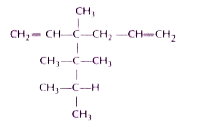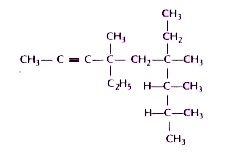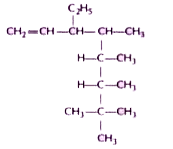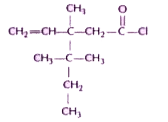REVIEW EXERCISES from NAGEEN CHEMISTRY (ENGLISH) ORGANIC CHEMISTRY : SOME BASIC PRINCIPLES AND TECHNIQUES for Class 11
| Class 11 | CHEMISTRY |
| Chapter | ORGANIC CHEMISTRY : SOME BASIC PRINCIPLES AND TECHNIQUES |
| NAGEEN CHEMISTRY (ENGLISH) | REVIEW EXERCISES |
| Medium | English |
| Academic Year | 2023-2024 |
Question 129
In the steam distillation of an organic oil (immiscible with water), the mixture of oil and water boils at 372 K under 1 atm pressure. The vapour pressure of water is 595 mm of Hg at this temperature. The collected condensate contains 50% by weight of the oil. Calculate the molecular weight of the oil.View SolutionQuestion 134
0.2346 g of an organic compound containing carbon, hydrogen and oxygen only were analysed by the combustion method. The increase in the weights of the U-tube and the potash bulbs at the end of the operation were found to be 0.2754 g and 0.4488 g respectively. Determine the percentage composition of the compound.View SolutionQuestion 143
An organic compound contains 69.4% carbon and 5.8% hydrogen. A sample of 0.303 g of this compound was analysed for nitrogen by Kjeldahl's method. The ammonia evolved was absorbed in 50 mL of 0.05 M H2SO4. The excess acid required 25 mL of 0.1 M NaOH for neutralisation. Determine the molecular formula of the compound, if its molecular mass is 121.View SolutionQuestion 146
A mono acid base gave the following results :
(1) On combustion 0.20 g of the base gave 0.58 g of CO2 and 0.15 g of water.
(ii) In Duma's method, 0.3 g of it gave 32.7 mL nitrogen at 288 K and 760 mm pressure.
(iii) 0.54 g of it required 12.50 mL of 0.4 N HCl for complete neutralisation.
Determine the molecular formula of the base.View SolutionQuestion 153
An organic compound (A) having C = 16.27%,H = 0.677%, Cl = 72.203% reduces Fehling solution and on oxidation gives an acid (B) having C = 14.679%, H = 0.612% and Cl = 65.137%. (B) on distillation with sodalime gives a sweet smelling liquid (C) which contains 89.12% chlorine. (C) can also be obtained by heating (A) with alkali. (A) can also be obtained by the action of Cl2 on C2H5OH. Identify (A), (B) and (C) and explain the reactions.View SolutionQuestion 155
A compound (X) having molecular formula C6H10 gave 2-methylpentane on treatment with H2 in the presence of Pd. When treated with dilute H2SO4 containing HgSO4, it yielded another compound having molecular formula C6H12O. Compound X did not react with ammonical CuCl and metallic sodium. Identity X.View SolutionQuestion 156
A dihaloalkane (A), C2H8Cl2 on reaction with alc. KOH gives (B), C6H6. (B) does not form white precipitate with ammonical silver nitrate and on hydrogenation absorbs two moles of hydrogen to give n-butane. Compound (B) reacts with two molecules of ozone to form a diozonide which on reductive hydrolysis gives two moles of formaldehyde and one mole of glyoxal. Identify (A) and (B) and explain the reactions.View SolutionQuestion 157
Establish the structure of a hydrocarbon C5H10 from the following facts :
(i) The hydrocarbon yields 2-methyl butane on catalytic reduction.
(ii) The hydrocarbon adds HBr to form a compound (B) which on reaction with moist silver oxide produces an alcohol (C).
(iii) The alcohol (C) on oxidation gives a ketone containing the same number of carbon atoms.View SolutionQuestion 158
A hydrocarbon (V.D. = 27) containing C = 88.88% decolourised KMnO4 solution and bromine water with evolution of HBr. It gave no precipitate with either ammoniacal silver nitrate or cuprous chloride solution. When treated with dil. H2SO4 in the presence of HgSO4, it gave methyl ethyl ketone. What is the hydrocarbon ? View SolutionQuestion 159
An organic compound (A) having V.D. = 30 contains C = 60.0% and H= 13%. On treatment with PCI5 it gave another compound (B) which contained 45.2% chlorine and on hydration it produced a hydrocarbon (C) containing 85.7% C and 14.3% hydrogen. On successive treatment with HI and moist silver oxide, (C) gave a compound (D) which was isomeric with (A). Identity (A), (B), (C) and (D) and explain the reactions.View SolutionQuestion 161
An aliphatic hydrocarbon (A) of molecular weight 58 yields on chlorination a monochloroderivative (B) which on treatment with aqueous alkali gives an alcohol (C). The alcohol shows positive Lucas test immediately and easily dehydrated to form the compound (D) which on ozonolysis yields a ketone (E) as one of the products. Dry distillation of the calcium acetate as well as heating of two molecules of acetic acid with MnO at 250°C also gives the same ketone (E). Identity compounds (A) to (E) and explain the reactions.View Solution
All Exercises from NAGEEN CHEMISTRY (ENGLISH) Class 11 CHEMISTRY ORGANIC CHEMISTRY : SOME BASIC PRINCIPLES AND TECHNIQUES
- REVIEW EXERCISES
- VERY SHORT ANSWER TYPE QUESTIONS
- SHORT ANSWER TYPE QUESTIONS
- ESSAY ( LONG ANSWER ) TYPE QUESTIONS
- OBJECTIVE ( MULTIPLE CHOICE ) TYPE QUESTIONS
- TRUE OR FALSE TYPE QUESTIONS
- FILL IN THE BLANK TYPE QUESTIONS
- ASSERTION - REASON TYPE QUESTIONS
- NCERT TEXT-BOOK EXERCISES (WITH HINTS AND SOLUTIONS )
- EXAMPLES



































